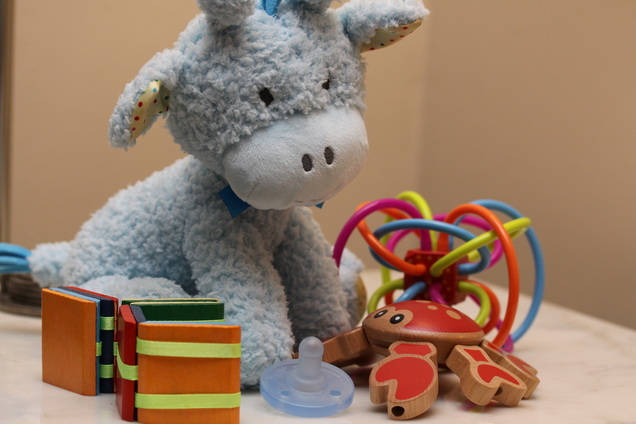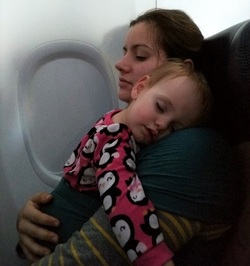Unsafe practices portrayed in advertisingWe took a trip recently, and on the shuttle from the Enterprise rental place to the airport there was this picture. I sat there staring at it, looked at other people staring at the ads, and it occurred to me; this is why parents don't know any better.
Let's review what's wrong:
1. A child should never wear bulky items while secured in a car seat. Even if it appears the straps are tight, the force of an accident will easily compress the item. Visuals - Crash Test Dummy and Strap Tightness Comparison 2. Straps should be tight to the chest. The tighter, the more the baby stays in a proper position and is secured correctly in the seat. Obviously straps shouldn't be so tight the baby can't breathe. 3. American car seats have a chest clip. This clip should be aligned with the armpits after the seat straps are pulled tight. 4. Although I couldn't say for certain, this child appears small enough, and therefore light enough to still be rear-facing. Many parents switch their children to forward facing far too early in terms of spinal development. The current recommendation is for a child to be rear-facing until "age 2 OR until they reach the maximum height and weight for their seat." Many car seats now have height and weight maximums that allow a child to remain rear-facing until they are 6 or 7, which is when most children would meet the weight maximum. Read more about why your child should be rear facing. So many times a child gets injured and the parent says "I didn't know any better". Not everyone is a researcher or strives to learn all the newest and safest recommendations. Many people base their actions on what they see, and what they see others do. Media and advertisement is a huge influence in our culture. They should think about what they are showing and if it adheres to the guidelines, recommendations, and safest practices. People are looking and watching, show the right standards.
0 Comments
The history, pros, and cons of the pacifierPacify: v. "quell the anger, agitation, or excitement of"
Pacifiers seem to be one of the number one baby items given to and accepted by new parents. Almost every baby you encounter has one in their mouth a vast majority of the time. There is a time and a place for a pacifier, and there is a time when pacifiers can be detrimental and should be avoided. The History of the Pacifier The first soothing items used by parents for centuries were water or honey dipped knotted rags, "gum sticks" made of stone, coral, or bone, and wooden beads. It wasn't until 1901 that a "new and original design for a baby comforter" was introduced by Christian W. Meinecke. This pacifier resembles most modern pacifiers, made of a rubber nipple attached to a shield. These initial pacifiers were definitely not up to today's standards and were commonly processed with sulfur, tinted white with a lead-containing compound, and the disk shields were made of ivory, aluminum, and sometimes bone. By the 1940's latex and silicone nipples with a plastic shield were the norm, produced primarily by Binky Baby Products of New York. Need Babies experience a primal inherent need to suck. This need stems from the evolutionarily tuned desire to find the breast, nurse, and receive nutrition. This is a wonderful reflex that helps to bring in the mothers milk and sustain her supply. Some babies do appear have a more persistent suck reflex than others, insisting on sucking for a soothing, comforting, non-nutritional purpose. The Pros of the Pacifier Whether you are breastfeeding or bottle feeding a pacifier can be useful. Breastfeeding - your baby has a seemingly insatiable need to suck. This can be exhausting to a nursing mother who's baby cries when not sucking on the breast. A pacifier can act as a replacement and allow the mother a break. Bottle feeding - Bottle fed babies are at greater risk of being overfed, and therefore overweight if they are continually given a bottle of milk when their soothing suck reflex is confused with a hunger suck reflex. Pace feeding can help this issue, but if not, a pacifier at the end of a feed will continue to allow the soothing sucking reflex without overfeeding the baby. The Cons of the Pacifier There are times when a pacifier can be detrimental. Breastfeeding - nipple confusion can be a reality and a challenge for some parents. Not every baby will have an issue going between breast and artificial nipple. Since we can not know which baby will or will not have a problem, it is best to err on the side of caution and wait until the baby is a least 4 weeks old, or better, until the mother's milk supply is well established at 6-8 weeks. Artificial Nipple - Extended use of a pacier can deform the palate and cause oral and dental issues later in life. Additionally, pacifiers may contribute to an increase in ear infections. Non-Judgmental Support You should never feel judged for using a pacifier. If it's what's working for you and your family, then you should certainly feel great using one! If issues arise, they can be dealt with and solutions can be proposed to move forward. You are not ruining your child forever by using one. Nor should you feel pressured into using a pacifier so the baby "isn't pacifying at the breast." If you love snuggling with your baby all day, every day, and have no issue with the amount of time your baby is on you, then go for it! A baby does not NEED a pacifier. You are not ruining your child forever by not using one. Tips and tricks for flying with child under twoMy daughter has flown 5 times in her first year of life, and I have to tell you; It's been really easy. 3 out of the 5 times, I have even been by myself.
Through these travels, I have discovered some helpful tips and tricks for flying with a baby.
Most importantly, it is only a slight amount of time in your life. You are a strong person and an incredible parent. You can handle this. Wrap your baby up in a carrier, snuggle and kiss, hum a song, rock back and forth, and just stay in your own little world with your child. P.S. Unsolicited ad for Southwest: We now never fly anything besides Southwest (when available). You get two checked bags for free. There isn't a fee to use your airline credits if you have to reschedule your flight. Families with a child under 6 can board together between the A group and the B group. They've taken to presenting their safety announcements with humor, which starts the flight off on a good note. I feel all of these components make them very baby and family friendly. Music During Labor and BirthThey say smell is one of the strongest senses tied to memory. I think music is even stronger.
Think of when a song comes on that you haven't heard in forever, and bam you're right back to jamming at your middle school homecoming dance. You know all the words, even though you can't remember geometry; but your jam, it will forever be in your soul. I had a specific Pandora station I listened to towards the end of my pregnancy and during my birth. This is now my daughter's station, as she is familiar with all the songs. When we played this familiar music to her in the early postpartum period it soothed her better than any shushing. One song in particular we call the baby song - What a Day (2008) by Greg Laswell. "What a day to welcome a baby to begin breathing." This lyric stuck with me and I knew I needed to hear it while I was in labor. And there was a time during my labor I had this song on repeat. It was my day to welcome my baby to begin breathing. Whenever this song comes up on our Pandora station I am brought right back to a very special time surrounding the introduction of my baby to this world. Should you make a labor playlist? It's up to you! You never know what you might want to listen to, and you might not want to listen to anything. I had an Enya playlist all set up, and I listened to it a bit, but found I actually wanted my normal playlist on with my lyrical songs I could get into. If you have time and enjoy making playlists, go for it! But if it's stressing you out to have one more thing on your "must do" list. Skip it. Your doula probably has a playlist set up anyways ;) My top baby playlist songs:
Not the most standard labor songs, but these touched my heart and will forever bring me back to the birth of my daughter in our little Colorado apartment during the snow of winter. |
Categories
All
Archives
December 2019
|




 RSS Feed
RSS Feed